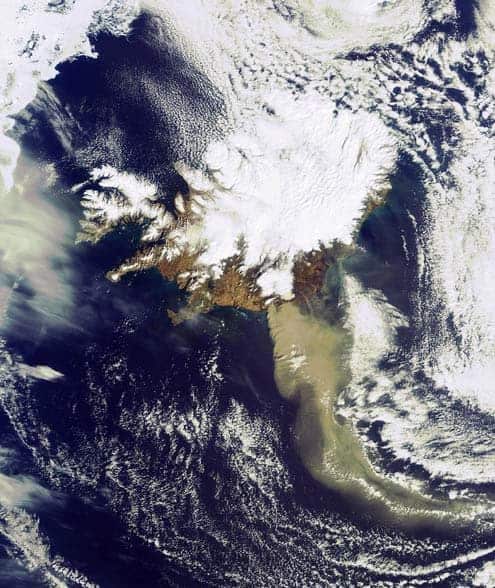
Ash from the Icelandic volcano Eyjafjallajökull was electrically charged as it wafted over Scotland last month, according to researchers in the UK who launched instruments into the plume. The team believes that collisions between ash particles maintain the charge and suggest that the effect could be used to detect the otherwise elusive ash particles, which have caused major disruptions to air travel since the eruption began on 14 April.
Volcanic eruptions are often accompanied by spectacular displays of lightning, so it’s not surprising that ash can be electrically charged as it spews out of a volcano. However, scientists know that the charge dissipates rapidly as the ash moves away from the volcano. This means that no measurable charge should have remained in the ash above south-western Scotland that was studied by Giles Harrison and Keri Nicoll of the University of Reading and colleagues.
Racing to Scotland
In April Harrison and Nicoll raced northwards to launch a balloon-borne collection of instruments into a plume of ash from Eyjafjallajökull that was drifting over Scotland. The kit, which is usually used to study clouds of sand kicked up by desert storms, included a spherical electrode exposed to the air. During the flight, the electrode voltage was set to 4 V every 60 s and the charge density in the air is determined by the rates of change of the voltage and altitude during that period. Another instrument measured the concentration and size of the particles by scattering laser light from the ash.
The balloon entered the plume at an altitude of about 3.7 km and found it to be about 500 m thick with sharp boundaries. The charge density was fairly uniform within the cloud, having a value of about 0.5 pC/cm-3.
The team found that most ash particles were less that 2.6 µm across, with the average diameter being about 1.4 µm. The instrument also determined that the ash concentration was less than 100 particles per cubic centimetre.
These parameters allowed the team to calculate the charge relaxation time of the plume, which was about seven minutes. However, the ash had left the volcano about 32 hours before reaching Scotland, and therefore the team is confident that the measured charge was much too large to have been created during the eruption.
‘Fair weather charging’ ruled out
A cloud of airborne particles can also experience “fair weather charging”, which is caused by the tiny vertical electrical current that is always present in the atmosphere. When this current crosses the boundary between clean air and particle-laden air, charge builds up at the top and bottom of the cloud but not in the middle. However, Harrison and colleagues measured charge within the ash cloud, suggesting that fair weather charging was not responsible for the ash’s electrical properties.
Harrison said that the charging is likely to be “a result of particle–particle collisions, which has been reported before as a possible charging mechanism for volcanic plumes”. This “triboelectric” effect is familiar to anyone who has experienced an electric shock after dragging their feet across a carpet.
He also told physicsworld.com that the charged nature of the ash cloud “might be useful is in detecting the ash remotely from an aircraft, as the small particles are difficult to detect with standard instruments such as radar”.
The work is reported in Environ. Res. Lett. 5 024004.



